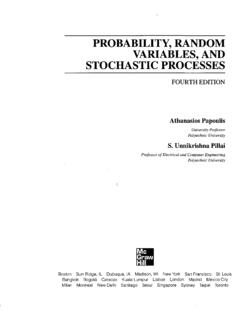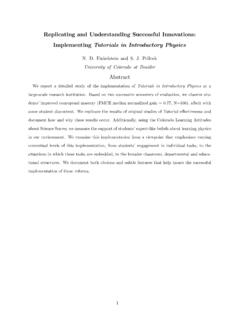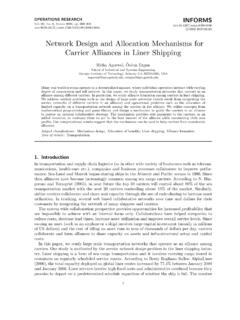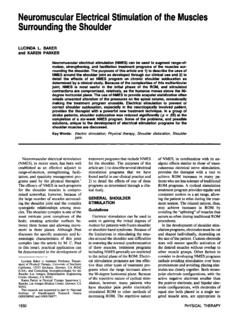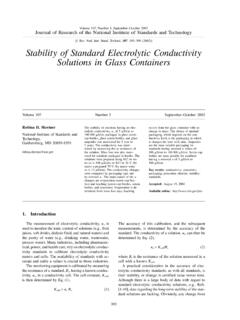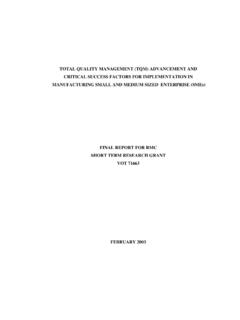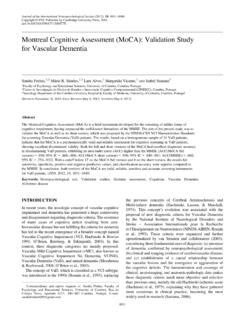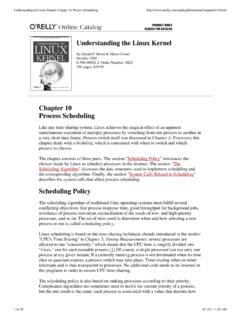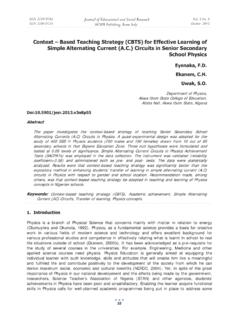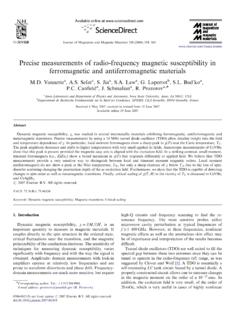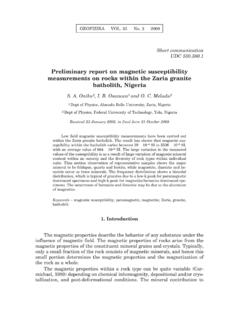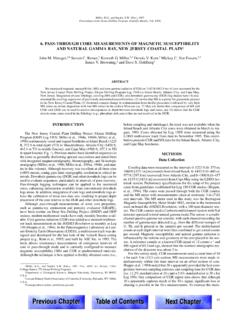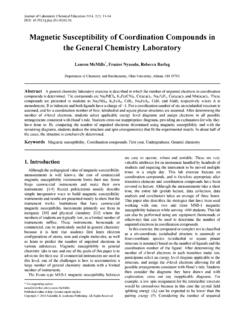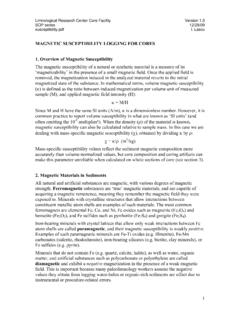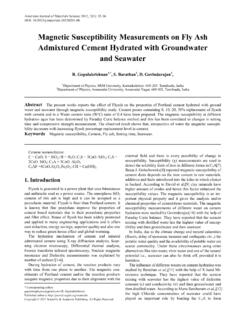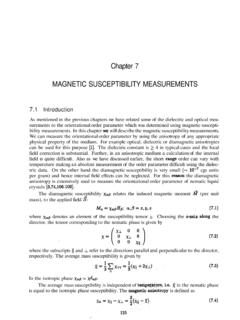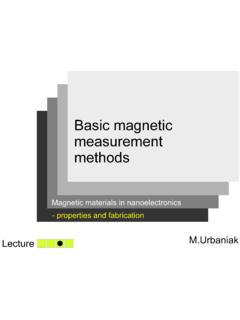Transcription of Magnetic Susceptibility Measurements of Solutions …
1 IntroductionThe magnetization and the Magnetic Susceptibility have beeninvestigated in various fields including inorganic chemistry,solid state physics, and material Measurements contain a lot of chemical andphysical information; thus they can be used to characterizeorganic and inorganic compounds. measurement of magneticsusceptibility of a solution is an essential physical analyticalmethod to determine the spin state and magnetization of a soluteas well as to determine the presence of a specific element Magnetic balance,3,4a vibration flux meter,5and aSQUID flux meter6have been widely used to investigate thespin state of solid compounds, metal complexes and Magnetic balance is a classical and simple method tomeasure the Magnetic force acting on a sample , its sensitivity is lower than that of the SQUID fluxmeter.
2 The SQUID flux meter has the highest sensitivity, but itis susceptible to Magnetic noise; hence, it is necessary to shieldwith a super-conducting material. Also, it is difficult by theSQUID flux meter to measure the reaction or change ofmagnetic Susceptibility of a solution sample directly. Thus, it isnecessary to develop an alternative Magnetic susceptibilitymetrology by a new principle in order to deal with a solutionsample. In our laboratory, a novel method of the magnetophoreticvelocimetry7,8has been developed to measure the magneticsusceptibility and the composition of individual micro-particlesand droplets in liquids by using a Magnetic force. In thistechnique, the size and the migration velocity of micro-particleare directly measured with an optical microscope; from theirvalues, the Magnetic Susceptibility can be the present study, a new principle to measure the magneticsusceptibility of a solution was proposed; we detected theair/solution interfacial displacement caused by the magneticforce to the solution.
3 The displacement was detected at thenanometer scale from the change of the interference fringes (socalled Newton-Rings)9generated between the solution surfaceand the upper surface of a small plano-convex lens attached onthe bottom wall of a cell. The displacement of the solutionsurface was investigated in relation to the magneticsusceptibility of Solutions as well as to the structure of themeasurement cell. The interference fringes were expanded orcontracted due to the changes of the molar concentration ofparamagnetic ions in solution. By the present method, it wasdemonstrated that the linear relationship between the magneticsusceptibility of paramagnetic ion Solutions and the interfacialdisplacement could be used as a calibration curve to determinethe Magnetic Susceptibility of solution aqueous solution of manganese(II) chloride (GR grade,Nacalai Tesque, Kyoto, Japan) was used as a standard solutionof the Magnetic Susceptibility .
4 The aqueous Solutions oflanthanide(III) chlorides, which included gadolinium(III)chloride (GdCl3 6H2O, , Nacalai Tesque), terbium(III)chloride (TbCl3 6H2O, 97%, Nacalai Tesque) and dysprosium(III)chloride (DyCl3 6H2O, , Nacalai Tesque), were preparedto be used as solution samples for the Magnetic susceptibilitymeasurements. To prepare the mixed solution of manganese(II)and dysprosium(III), we made a stock solution of dysprosium(III)by dissolving dysprosium oxide (Dy2O3, , NacalaiTesque) in 10 2M sulfuric acid. Then, this stock solutionwas diluted to [Dy(III)] = 10 3M with an aqueous solution1157 ANALYTICAL SCIENCES SEPTEMBER 2006, VOL. 222006 The Japan Society for Analytical ChemistryOriginal PapersMagnetic Susceptibility Measurements of Solutions by SurfaceNanodisplacement DetectionShigeki EGAMI, Hideaki MONJUSHIRO, and Hitoshi WATARAI Department of Chemistry, Graduate School of Science, Osaka University, Machikaneyama-machi, Toyonaka, Osaka 560 0043, JapanA new principle to measure the Magnetic Susceptibility of a solution was proposed; it utilized the displacement of solutionsurface caused by the Magnetic force applied to the solution.
5 The interfacial displacement was measured with thesensitivity of 5 nm from a change of the interference fringes, so called Newton Ring, generated from the solution surfaceand an upper surface of a small plano-convex lens on the bottom wall of a cell. The surface displacement measurementwas carried out in a homemade cell attached by one or two small Nd-Fe-B magnets. The performance of this method wasinvestigated by the Measurements of Magnetic Susceptibility of manganese(II) chloride solution and some lanthanide(III) Solutions . An excellent linear relationship between the Magnetic Susceptibility and the interfacial displacement wasobserved for each solution system. Then, it was demonstrated that this relationship could be used for the determination ofthe Magnetic Susceptibility of Solutions or the concentration of a solute by using the manganese(II) solution as a standardsolution.
6 (Received May 19, 2006; Accepted July 21, 2006) To whom correspondence should be : manganese(II) chloride. Triton X-100 was added to allsolutions in wt% to reduce their surface tension. Waterwas purified by a Milli-Q system (Millipore, Billerica, MA,USA) and the other reagents were used as received. Themagnetic Susceptibility of a sample solution was measured witha Magnetic balance (MSB-AUTO, Shaerwood Scientific Ltd.,Cambridge, UK).Interfacial displacement measurementFigure 1 shows schematically the air/solution interfacialdisplacement measurement system. An inverted microscopewas constructed of a cold light source (Mega Light 100,SCHOTT Nippon K. K.)
7 Fiber Optics, Japan), a band pass filter(wavelength 560 nm), a mirror, a half mirror, an objective lens(10 , 20 , Mplan Apo, Mitutoyo, Japan), a tube lens and a CCDcamera (CCD-IRIS DXC-108, SONY, Japan). The obtainedmicroscope images were monitored through a CCD camera,captured with a digital video camera recorder (DCR-TRV30,SONY, Japan), and analyzed using the image processingsoftware Image-J with a personal schematic illustration of two types of cells and thedisposition of magnets are shown in Fig. 2. Cell (A) is a simplecylindrical cell attached by one or two magnets, but cell (B) hasa separated action part close to a magnet and a detection part ofNewton 3(A) shows the principle of the interfacial nano-displacement device.
8 The sample solution was introduced to theacrylic cell, which had a small plano-convex lens (3 mm in1158 ANALYTICAL SCIENCES SEPTEMBER 2006, VOL. 22 Fig. 1 Experimental system for the Magnetic Susceptibility measurement of a solution by the nano-displacement of the air/solution interface. The light from a cold light source turned into amonochromatic light through a band pass filter. The wavelength was set to 560 nm. The obtainedmicroscopic images were monitored, captured with a DV camera recorder through a CCD, andanalyzed with a personal 2 The schematic illustrations of two types of cells (A) and (B), and the disposition of thepermanent magnet. Cell (A) is a simple cylindrical cell, but cell (B) has a separated action part closeto the magnet and a detection part of Newton , mm in radius of curvature, Edmund Optics) atthe center of the bottom wall.
9 To measure the height of thesolution surface, we observed the interference fringes (so calledNewton-Rings), which were produced by the light reflected atthe upper surface of the lens and the other light beam reflectedat the air/solution interface. Figure 3(B) shows an example of aNewton Ring observed in the case of an air/water to the interference condition of the Newton Ring,11,12the conditions for enhancement (bright-line) and counterbalance(dark-line) are expressed as Eqs. (1) and (2), respectively,h= = 2m(1)h= = (2m+ 1)(2)where his the distance between the lens and the air/solutioninterface, ris the radial distance from the lens center, Ris theradius of the lens curvature, nis the refractive index of asolution and mis an integer (m= 0, 1, 2.)
10 For instance, whenwater is used as sample solution and the wavelength is 560 nm,the difference in distance, h, between the lens and theair/solution interface observed from adjacent bright-dark ringsis about 105 a region close to the magnet in a cell, dia- andparamagnetic Solutions tend to move toward a smaller and alarger Magnetic field gradient, respectively. Figure 4 showsschematically a variation of the interference fringes in dia- orparamagnetic solution under the Magnetic field gradient, whichis generated by Nd-Fe-B magnet attached to the wall of a cell. 4nr2 2R 4nr2 2 RWhen a solution is diamagnetic, the interference fringes will becontracted, because the air/solution interface in the vicinity of alens is raised.
